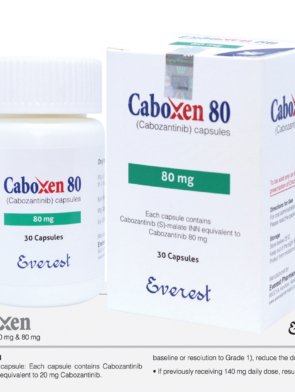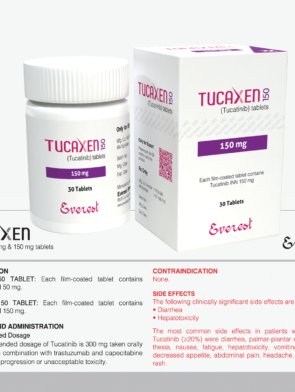MaxD (Cholecalciferol) 40000 IU
£0.00
The active form of Vitamin D3, Calcitriol, exerts its effect by binding to the Vitamin D receptors (VDRs) which are widely distributed through many body tissues.Vitamin D3 has a half life of about 50 days as it is fat soluble.Vitamin D3 is absorbed in the small intestine and bound to specific a-globulins and transported to the liver where it is metabolised to 25-hydroxy Vitamin D3 (Calcidiol).
A second hydroxylation to 1,25-dihydroxy Vitamin D3 (Calcitriol) occurs in the kidney. This metabolite is responsible for the vitamin’s ability to increase the absorption of calcium. Non-metabolised Vitamin D3 is stored in tissues such as fat and muscle.Vitamin D3 is eliminated via faeces and urine.
Add to wishlist
Share
CategoryUncategorized
Indications of MaxD 40000 IU
Colecalciferol (Vitamin D3) is indicated in the treatment & prevention of Vitamin D3 deficiency. It is also indicated as an adjunct to specific therapy for osteoporosis, osteomalacia, hypocalcaemia, tetany and rickets in patients with vitamin D3 deficiency. Cholecalciferol, synthetic form of Vitamin-D … Read moreColecalciferol (Vitamin D3) is indicated in the treatment & prevention of Vitamin D3 deficiency. It is also indicated as an adjunct to specific therapy for osteoporosis, osteomalacia, hypocalcaemia, tetany and rickets in patients with vitamin D3 deficiency. Cholecalciferol, synthetic form of Vitamin-D which is essential for normal bone growth and development and to maintain bone density. It is also necessary for utilization of both calcium and Phosphorus. Babies need Vitamin-D3 for healthy growth & development. It acts as a hormone.
Theropeutic Class
Vitamin in bone formation, Vitamin-D preparations
Pharmacology
Colecalciferol (Vitamin D3) helps for the absorption & reabsorption of Calcium & Phosphorous. Vitamin D3 is essential for normal bone growth & to maintain bone density. It also reduces the severity of bacterial infection, improves lung function, prevents the risk of cancer (breast, colorectal) & helps to maintain adequate insulin levels for type 2 diabetes patients.
Dosage & Administration of MaxD 40000 IU
For capsule: Adults: Treatment of Vitamin D3 deficiency: 40000 IU once weekly for 7 weeks. Doses for maintenance therapy is 1400-2000 IU/day. To confirm the target level of 25 hydroxyvitamin D, measurement of it should be determined 3-4 months after initiating the maintenance therapy. Prevention of Vitamin D3 deficiency: 20000 IU every 4 weeks. Higher doses may be required in certain situations. Addition to specific therapy for osteoporosis: 20000 IU once a month. For capsule: Children (12-18 years): Treatment of Vitamin D3 deficiency: 20000 IU once every 2 weeks for 6 weeks. Prevention of Vitamin D3 deficiency: 20000 IU every 6 weeks. For film-coated tablet: 1000 IU (1-2 tablets) daily, or as directed by physician. Take the medicine with food or within 1 hour after a meal.For oroflash or chewable tablets: 1000 IU to 2000 IU daily, or as directed by physician. Take the medicine with food or within 1 hour after a meal. Place the tablet in mouth swallow after chewing.For Syrup:For patients with risk of Cholecalciferol deficiency: 0-1 yr: 400 IU/ day (2 ml) >1 Yr: 600 lU/ day (3 ml) For Cholecalciferol deficient patients: 0-1 yr: 2000 IU/ day (+50000 IU/week ) for 6 weeks 1 -18 yrs: 2000 IU/ day for 6 weeks. Injection: Prevention: Infants receiving Vitamin D enriched milk: 1/2 ampoule (0.5ml) i.e. 1,00000 I.U. every 6 months. Nursed infants or infants not receiving Vitamin D enriched milk or young children up to 5 years of age: 1 ampoule (1ml) i.e. 2,00000 I.U. every 6 months. Adolescents: 1 ampoule (1ml) i.e. 2,00000 I.U. every 6 months during winter. Pregnancy: 1/2 ampoule (0.5ml) i.e. 1,00000 I.U. from the 6th or 7th month of pregnancy. Elderly: 1/2 ampoule (0.5ml) i.e. 1,00000 I.U. every 3 months. Digestive disorders, concomitant treatment with antiepileptics & other particular condition not described above; 1/2 ampoule (0.5ml) i.e. 1,00000 I.U. or 1 ampoule (1ml) i.e. 2,00000 I.U. every 3 or 6 months. Injection: Vitamin D deficiency: 1 ampoule (1ml) i.e. 2,00000 I.U. which can be repeated 1 to 6 months later. Or, as directed by the registered physician.
Dosage of MaxD 40000 IU
For capsule: Adults: Treatment of Vitamin D3 deficiency: 40000 IU once weekly for 7 weeks. Doses for maintenance therapy is 1400-2000 IU/day. To confirm the target level of 25 hydroxyvitamin D, measurement of it should be determined 3-4 months after initiating the maintenance therapy. Prevention of Vitamin D3 deficiency: 20000 IU every 4 weeks. Higher doses may be required in certain situations. Addition to specific therapy for osteoporosis: 20000 IU once a month. For capsule: Children (12-18 years): Treatment of Vitamin D3 deficiency: 20000 IU once every 2 weeks for 6 weeks. Prevention of Vitamin D3 deficiency: 20000 IU every 6 weeks. For film-coated tablet: 1000 IU (1-2 tablets) daily, or as directed by physician. Take the medicine with food or within 1 hour after a meal.For oroflash or chewable tablets: 1000 IU to 2000 IU daily, or as directed by physician. Take the medicine with food or within 1 hour after a meal. Place the tablet in mouth swallow after chewing.For Syrup:For patients with risk of Cholecalciferol deficiency: 0-1 yr: 400 IU/ day (2 ml) >1 Yr: 600 lU/ day (3 ml) For Cholecalciferol deficient patients: 0-1 yr: 2000 IU/ day (+50000 IU/week ) for 6 weeks 1 -18 yrs: 2000 IU/ day for 6 weeks. Injection: Prevention: Infants receiving Vitamin D enriched milk: 1/2 ampoule (0.5ml) i.e. 1,00000 I.U. every 6 months. Nursed infants or infants not receiving Vitamin D enriched milk or young children up to 5 years of age: 1 ampoule (1ml) i.e. 2,00000 I.U. every 6 months. Adolescents: 1 ampoule (1ml) i.e. 2,00000 I.U. every 6 months during winter. Pregnancy: 1/2 ampoule (0.5ml) i.e. 1,00000 I.U. from the 6th or 7th month of pregnancy. Elderly: 1/2 ampoule (0.5ml) i.e. 1,00000 I.U. every 3 months. Digestive disorders, concomitant treatment with antiepileptics & other particular condition not described above; 1/2 ampoule (0.5ml) i.e. 1,00000 I.U. or 1 ampoule (1ml) i.e. 2,00000 I.U. every 3 or 6 months. Injection: Vitamin D deficiency: 1 ampoule (1ml) i.e. 2,00000 I.U. which can be repeated 1 to 6 months later. Or, as directed by the registered physician.
Interaction of MaxD 40000 IU
It interferes with phenytoin, barbiturates, glucocorticoids, certain laxative (such as liquid paraffin), actinomycin and imidazole antifungal agents.
Contraindications
It is contraindicated in patients with known hypersensitivity to Vitamin D3.
Side Effects of MaxD 40000 IU
The general side effects are hypercalcaemia, hypercalciuria, skin rash, pruritus, urticaria, nausea, abdominal pain.
Pregnancy & Lactation
Studies have shown safe use of doses up to 4000 IU during pregnancy. The recommended daily intake for pregnant women is 400 IU, however, in women who are considered to be Vitamin D3 deficient a higher dose may be required. During pregnancy women should follow the advice of their medical practitioner as their requirements may vary depending on the severity of their disease and their response to treatmentVitamin D3 and its metabolites are excreted in breast milk. Overdose in infants induced by nursing mothers has not been observed; however, when prescribing additional vitamin D3 to a breast-fed child the practitioner should consider the dose of any additional vitamin D3 given to the mother.
Precautions & Warnings
It should be used with caution in patients with impaired renal function.
Overdose Effects of MaxD 40000 IU
It can lead to hypervitaminosis D.
Storage Conditions
Keep below 30º C temperature, protected from light & moisture. Keep out of the reach of children.
Use In Special Populations
The safety & efficacy of Vitamin D3 in children under 12 years have not been established.
Drug Classes
Vitamin in bone formation, Vitamin-D preparations
Mode Of Action
Colecalciferol (Vitamin D3) helps for the absorption & reabsorption of Calcium & Phosphorous. Vitamin D3 is essential for normal bone growth & to maintain bone density. It also reduces the severity of bacterial infection, improves lung function, prevents the risk of cancer (breast, colorectal) & helps to maintain adequate insulin levels for type 2 diabetes patients.
Pregnancy
Studies have shown safe use of doses up to 4000 IU during pregnancy. The recommended daily intake for pregnant women is 400 IU, however, in women who are considered to be Vitamin D3 deficient a higher dose may be required. During pregnancy women should follow the advice of their medical practitioner as their requirements may vary depending on the severity of their disease and their response to treatmentVitamin D3 and its metabolites are excreted in breast milk. Overdose in infants induced by nursing mothers has not been observed; however, when prescribing additional vitamin D3 to a breast-fed child the practitioner should consider the dose of any additional vitamin D3 given to the mother.
Pediatric Uses
The safety & efficacy of Vitamin D3 in children under 12 years have not been established.
| Generic Name: | Cholecalciferol [Vitamin D3] |
|---|---|
| Theraputic Category: | Vitamins & Minerals |
| Pack Size: | 1×7's |
Be the first to review “MaxD (Cholecalciferol) 40000 IU”
You must be logged in to post a review.





Reviews
There are no reviews yet.